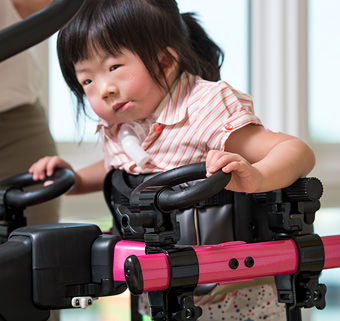Pacer Prompt Reduction
Part 1: Concepts for Mobility Skill Building
| July 2019
See also: Part 2: Prompt Reduction Strategies.
Using the Rifton Pacer’s full range of adjustment possibilities will help you meet goals for mobility and activity. Individuals who cannot bear weight fully through their lower extremities, or need prompting for alignment need appropriately positioned prompts and supports. Motor skills acquisition and strength building are best achieved when an individual is given just enough support to facilitate weight bearing and enable movement.
The Rifton Pacer works effectively with the MOVE™ Program. The MOVE approach to teaching functional motor skills is to move first, even if the movement is imperfect, and then to refine the movement for greater efficiency and independence. A core concept of MOVE is to provide only as much support as the learner requires to accomplish a task, aiming for a level of “just manageable difficulty,” which is the point at which both the task and the environmental context challenge an individual to create an effective learning and practice opportunity. As an individual’s abilities improve, systematically reducing and removing supports or prompts will encourage independence from those supports. Moving while upright, weight bearing while standing, and participating in activities with less assistance are beneficial regardless of whether an individual achieves complete independence from support.
The Pacer’s prompts have two purposes: weight-bearing assist and positioning for alignment. Weight-bearing assist occurs:
- Through the forearms with the arm prompts or arm platforms
- At the chest with the chest prompt
- At the pelvis with the multi-position saddle (MPS), hip positioner or pelvic support
Positioning for alignment occurs:
- At the shoulders with the arm prompts/platforms
- At the trunk with the chest prompt
- At the pelvis with the multi-position saddle (MPS), hip positioner, or pelvic support
- At the thighs with the thigh prompts
- At the ankles with the ankle prompts
For a highly dependent individual needing maximum weight-bearing support:
- Adjust the arm prompts or arm platforms so that the individual is comfortable and is able to bear weight through the prompts. In time, they can be adjusted to a more functional position.
- Tilt the chest prompt forward so that the individual can bear weight on the front portion of the prompt.
- Raise the seat of the multi-position saddle (MPS), hip positioner or pelvic support to increase weight bearing at the pelvis.
With the casters locked, begin with supported standing. After the individual becomes accustomed to standing, move the Pacer forward. The movement of the device may be enough to stimulate stepping. You can also position the spring adjusters of the ankle prompts so that the ankle straps provide a physical cue to step. It may be necessary to move the individual’s legs manually at first. Eventually the individual will begin to initiate reciprocal stepping, particularly when motivated by the environment or context. Allow the individual wait time for problem solving and learning by discovery.
Individuals who have difficulty initiating forward movement may have more success in a forward-leaning position. To achieve a forward leaning position:
- Move the seat of the MPS (or pelvic support or hip positioner) backward relative to the trunk and upper extremity supports and tilt the seat forward.
- Tilt the chest prompt forward.
- Move the arm prompts or arm platforms forward on the oval bars.
The Pacer casters have adjustments that can aid mobility. Engage the swivel lock on the rear casters for easier steering. Use the direction locks to prevent backward movement. The variable wheel drag can promote leg strengthening and help an individual who veers toward one side, or slow down a fast mover. (View Functions of the Pacer Caster video.)
As an individual’s abilities improve, reduce forward lean. Angling the arm prompts or arm platforms upward assists with head and upper trunk control. Efficient placement of the multi-position saddle (MPS), hip positioner, or pelvic support, along with chest prompt tilt, enables a more vertical or neutral positioning of the pelvis in relation to the shoulders. Thigh prompts and ankle prompts guide step placement and stride length, and provide leg abduction.
Here are a few possible strategies for prompt reduction consideration:
- Remove the multi-position saddle (MPS), hip positioner or pelvic support for an individual who quickly develops improved weight-bearing ability.
- Loosen and lower the chest prompt to permit more weight shifting for an individual who is gaining trunk control.
- Remove the chest prompt while the arm supports and leg control prompts are still in use when individual needs help with leg placement and positioning but has good trunk control and balance.
- Use the ankle prompts without the thigh prompts to limit stride length for an individual who needs help with movement control. Increase the spacing of the ankle prompt spring adjusters as walking ability improves.
- Remove arm prompts for individuals who function best when their arms are not restricted. Certain individuals with extreme spasticity may utilize their ATNR reflex to promote step taking, and may walk with less effort with arms free.
- Use arm supports only. When the upper extremity supports are removed last, the individual has maximal opportunity to develop control of the trunk, pelvis, hips and legs for independent walking. As the individual progresses toward independent walking, try switching to the handholds or hands on the Pacer frame for greater independence. (Note: When using the arm prompts or arm platforms only, do not place them at the extreme front or rear of the Pacer, as it will negatively affect stability.)
Activity is important regardless of the quality of movement or how much support is required. An individual’s gait may not be perfect, but there are huge benefits to active limb use and independent movement.
Learn more: www.move-international.org
Watch An Introduction to MOVE Webinar.




